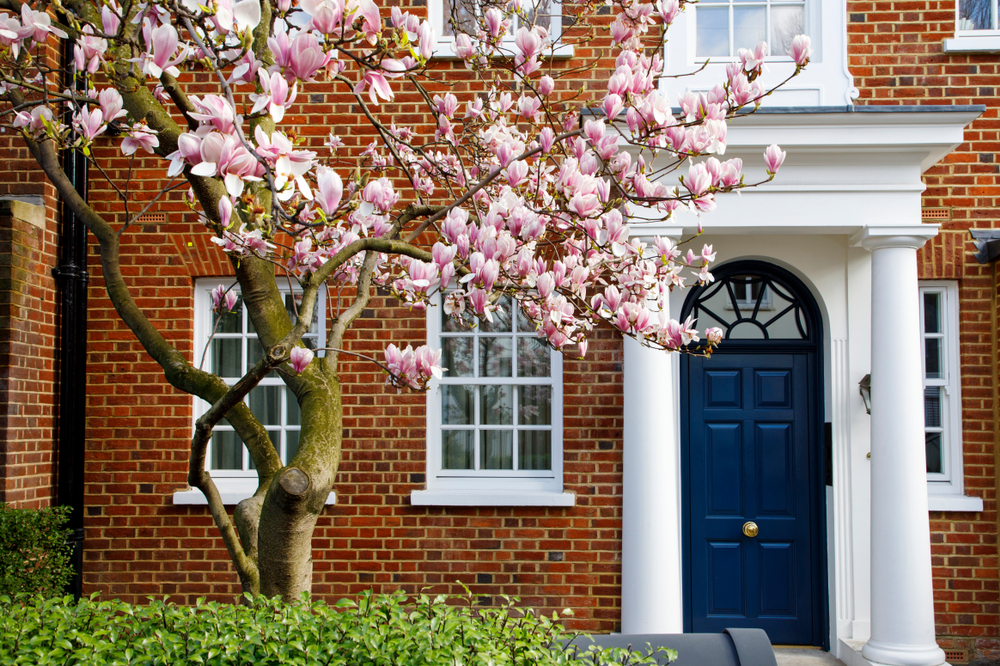The Bishops Avenue, Hampstead, is one of the most exclusive addresses in London and is often labelled 'Billionaires' Row.' This highly prized nickname was coined due to the 66 palatial properties that line the street, most of which are worth many millions of pounds each. Unsurprisingly properties on the street are owned (or rented, in the case of Justin Bieber) by the ultra-wealthy, with past and present residents including billionaire industrialists and royal families.
Bishops Avenue London
The Bishops Avenue hasn't always hit the headlines for positive reasons, however, a 2014 Guardian investigation found that around £350 million worth of property on the street was either empty or derelict, and it’s believed many remain uninhabited today. Real estate here remains highly prized, now paving the way for development opportunities, with 30 luxury new flats being built across three blocks on the site of an uninhabited £18 million mansion that burned down in the summer of 2022.
The development is something of a win-win: new owners can live on one of London's most exclusive and well-known streets in a luxurious property, and developers can take advantage of a single, spacious plot to deliver multiple residences, which is likely more profitable than renovating the existing property on the site. For their part, the local community will also benefit from a rejuvenated plot and more full-time residents on the street who will bring a new lease of life to the avenue.
Hampstead remains a sought-after location in London, especially for families that appreciate being near open spaces and amenities: Hampstead Heath and Highgate Golf Club are just a stone's throw away from the new development, which is the first of its kind on the street. As is Highgate School, a leading co-educational independent school founded in 1565 and notable English heritage property Kenwood House. For prospective owners, the opportunity to live on The Bishops Avenue will likely be an enticing proposition, given the street's location and prestige. With properties usually costing several million pounds, however, purchasing a flat is likely to be a more accessible way to live in such an ideal location for many.
Financing
Arguably, it used to be easier to reap relatively significant profits from developing or renovating property, even for non-professionals working on their own home. However, today's buyers are savvy, and simple cosmetic changes to a residence won't dramatically increase a property's value or sale price if the work doesn't add intrinsic worth to the residence. There are also fewer real 'bargain' properties in the UK, making it hard to find highly profitable development projects, especially when factoring in increased labour and material costs.
Get in the Know
Subscribe to our newsletter
There is, of course, still very significant profit to be made from developing commercial or residential property, but to get the best return on investment, developers tend to need to take on more challenging or larger projects. Here, it's possible to see why The Bishop's Avenue is so enticing to developers: they've been able to purchase a prime plot of land and get planning permission for a multi-unit property on the site of what is currently a single mansion. Given the scale and value of the plot and existing property, the required finance is likely to have been significant. However, the project is equally likely to deliver exceptional return on investment for developers, Valouran.
Opportunities
Building a multi-unit property on the site of what is originally a single residence or real estate asset is relatively standard. However, these are usually ambitious projects, even if they are significantly smaller than The Bishops Avenue project (renovating and converting a large residence into flats or building two properties on one plot of land, for example).
The opportunities for developing a multi-unit property on the plot of a single dwelling are extensive, although these do tend to be complex projects to take on, not least because of the significant sums of capital required to deliver multi-unit real estate.
The most obvious benefit for developers is that a multi-unit property will increase the number of properties available to rent or sell on an existing plot, maximising land usage. This will usually increase revenue for developers, even considering higher development costs.
Multi-unit properties often deliver different-sized properties: The Bishop's Avenue development will see one- and two-floor flats and two- to four-bedroom penthouses brought to market, for example. In this case, developers will adapt a single site to meet different market demands, delivering prime penthouses and smaller luxury flats on the same development that will presumably hit the market at a lower price point. The result is that developers will have a larger target market to sell the properties to rather than a narrower selection of buyers, which would be the case if they rebuilt the existing mansion on the plot.
While large-scale developments that see a single dwelling converted into multiple properties usually require very significant financing, building multiple units on a single plot will usually reduce the cost of construction per unit, compared to developing several projects in different locations and will make the project easier to manage.
Structuring Finance
Development finance is pivotal to the success of multi-unit projects, which usually require a relatively significant loan. Under the umbrella of 'development finance' (which can cover everything from a complete renovation of your home to the building of a central London skyscraper), there are many different types of finance which vary in terms of length, flexibility and structure.
Speaking to an adviser like Enness with whole-of-market access to lenders is key to understanding your options and any drawbacks or benefits of a specific type of facility. Chris Witney, Head of Specialist lending at Enness Global explains, ‘Some development finance can exclusively be used to purchase a plot of land, for example. In contrast, other loans will cover the whole of the development costs (minus the developer's own equity) and will typically see funds released as stages of the project are completed: a first tranche to purchase a plot of land or property and then subsequent tranches at predefined stages of the build or renovation. Developers building multi-unit real estate on the site will usually need to opt for this route'.
Finance for the development of multi-unit property on the site of a single dwelling is readily available from lenders, who are willing to finance small projects handled by individuals or first-time developers with a compelling project, as well as experienced developers taking on large-scale projects. Lenders, however, will only ever fund a quality development: they will be looking closely at gross development value (GDV, i.e. the anticipated value of the completed development) and the costs of any work that needs to be undertaken. A watertight case for deploying funds, a plan for managing expenses and contractors or building partners, and a defined timeline (builds that take longer than anticipated eat into projected profits and affect developers' ability to refinance or exit easily) are essential to get this kind of financing project off the ground.
Will Bishops Avenue Remain London’s Billionaire’s Row?
Of course the addition of apartments will reduce the average value of property on this prized north London street. And with the likes of Kensington Palace Gardens and St John’s Wood Avenue Road and Hamilton Terrace continue to see single dwelling purchase and development, its perhaps not inconceivable for the crown of London’s Billionaire Row to change hands in the mid term.
Get In Touch
Enness is a specialist broker of high-value development finance. We work with individuals looking to take on ambitious development projects, as well as seasoned developers undertaking large projects, which include hotels, multi-unit residences, mixed-use real estate, commercial properties, industrial premises and so on. Contact us to discuss a project you are considering undertaking, and we can talk you through financing options.





